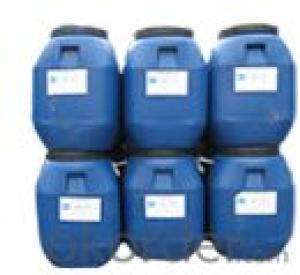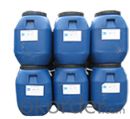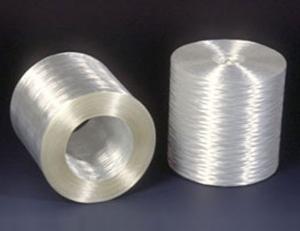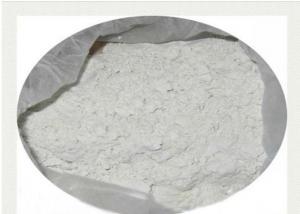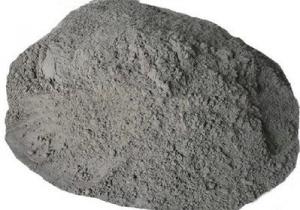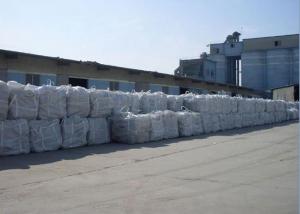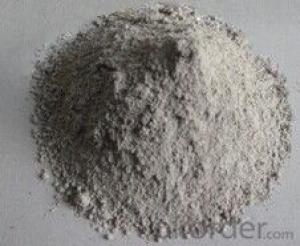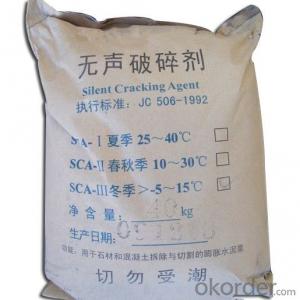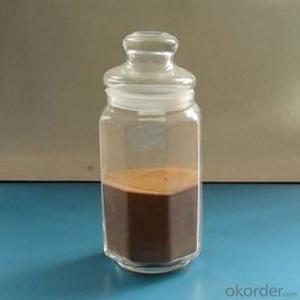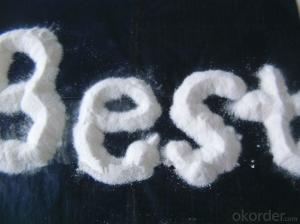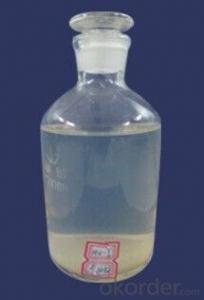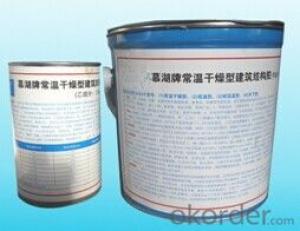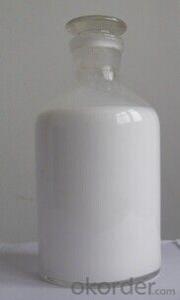High strength pourable epoxy resin grout(MH-EP)
- Loading Port:
- China Main Port
- Payment Terms:
- TT OR LC
- Min Order Qty:
- -
- Supply Capability:
- -
OKorder Service Pledge
OKorder Financial Service
You Might Also Like
High strength pourable epoxy resin grout(EP)
Description
EP is a three-component pourable grout, based on a solvent free epoxy resin and selected aggregates. EP cures to form a hardened mortar with excellent adhesion to many substrates. This combined with the product’s ease of application makes it ideally suited to site application.
Uses
It is mainly applied for repairing of concrete substrate which includes 1-15mm uneven surface and 15-100mm deep hole.
As a self smoothening mortar: Repairing and patching horizontal surfaces.
Advantages
High early strength
High tensile and flexural strength, vibration resistant.
Unaffected by wide range of chemicals
Storage and Shelf life
Minimum shelf life is 1 year. Store under controlled conditions in original containers from 5 – 35 ℃.
Instructions for Use
1. Surface Preparation
Mechanically roughened, free from all contaminants (Eg. Dust, oil, grease, ice, etc.), surface water, laitance, old form oil, curing membrane and old coatings. Suitable methods of preparation include blast cleaning and scrabbling (sanding/grinding on fibrous cement). All dirt must be removed from bolt by air blasting.
2. Primer Application
Apply #3 Epoxy resin primer tack coat application method for substrate surface treatment. Apply by brush, roller or squeegee and scrub well into substrate. When maximum waiting times are expected to be exceeded lightly broadcast with kiln dried quartz sand (0.4 – 0.7 mm) at a maximum of 1.0 kg/m2. Remove excess before application of second coat.
Second coating layer # 5 Epoxy resin primer should be applied ( while the substrate exposed in the air. Therefore, the first layer should be brushed carefully. When the second coating applied after more than 48 hours, broadcast with dried quartz sand (0.4 – 0.7 mm) at a maximum of 0.8kg/m2. Attentions should be taken to avoid excessive quartz sand in the primer.
3. Mixing
EP is supplied in factory proportioned units comprising the correct quantities of Part A (resin), Part B (Hardener) and Part C (Aggregate). Thoroughly stir Parts A and B separately using a slow running drill stirrer with a spiral mixer. Decant all the Part B into Part A and mix thoroughly together until a uniform mix is achieved (typically 2 minutes). Continue to mix whilst adding Part C slowly. Ensure the attainment of an even color and an even distribution of aggregate throughout the mix.
Reduce quantity of component C if high material flowable required; Regulate proportion of component A and component B if application should be extended. For example, regulate the mixing proportion of component A to component B in 6: 1 instead of 5: 1. The actual mixing proportion should be confirmed by the test at site.
4. Thickness
Generally, suitable thickness depends on clearance, distance of flow, ambient and substrate temperatures and pour size. Maximum thickness in each pour is 50mm.
5. Curing
Being an epoxy, no special curing techniques are required. Curing time will depend on the quantity and the ambient temperature. High volumes and high temperatures result in short curing times. Do not install equipment or load the epoxy before full cure.
6. Cleaning
Uncured material may be cleaned from application tools, etc. Using MUHU-cleaner (flammable solvent). Cured material can only be removed mechanically.
Technical and Physical Data
Form: Repair mortar
Density: ≥2.0kg/liter
Volume solids: 100% (solvent free)
Mix ratio: A: B: C = 5: 1: 25-30 (by weight)
Compressive strength:
1-15mm epoxy resin repair mortar | 15-100mm epoxy resin repair mortar | |||
Compressive strength | 1 day | Approx. 50MPa. | 1 day | Approx. 60 |
7 days | Approx. 90MPa. | 7 days | Approx. 100MPa | |
Adhesiveness | 20℃ | approx. 4 MPa (Concrete mixing failure) | ||
Application temperature | 5 – 35℃ (substrate and ambient temperatures) | |||
Color: Part A – Transparent (water white), Part B – Transparent (straw)
Part C – White sand
Straw when mixed.
Packaging: 50kg.
Potlife: 30 minutes (at 25℃)
Important Notes:
Do not apply EP to surfaces with standing water.
Only mix as much as can be applied within the stated potlife.
Do not dilute the product with solvent as this will affect both the cure and in-service performance.
Handling Precautions
Avoid contact with the skin, eyes and avoid breathing it’s vapor.
Wear protective gloves when mixing or using.
If poisoning occurs, contact a doctor or Poisons Information Centre.
If swallowed, do NOT induce vomiting. Give a glass of water.
If skin contact occurs, remove contaminated clothing and wash skin thoroughly.
If in eyes, hold eyes open, flood with water for at least 15 minutes and see a doctor.
Note:
The information, in particular, the recommendations relating to the application and end-use of products. In practice, the differences in materials, substrates and actual site conditions are such that no warranty in respect of merchantability or of fitness for a particular purpose, nor any liability arising out of any legal relationship whatsoever, can be inferred either from this information, or from any written recommendations, or prietary rights of third parties must be observed.
- Q: Civil building insulation materials, combustion performance grade A What is the material
- In the benefits of low-carbon energy-saving thermal storage materials (slurry) can collect excess heat, timely and stable fit. To achieve the role of Dongnuanxialiang, the detection reached the national A-level fire safety standards. :
- Q: Brick and concrete structure and frame structure in the force system, the use of building materials and the scope of the three aspects of the difference. Thank you ~ ~ very anxious
- Wind load transfer wall → foundation → foundation → crust Frame structure: gravity load transfer floor panel → secondary beam → frame beam → frame column → foundation → foundation → crust Wind load transfer wall → frame (assigned to frame column) → foundation → foundation → crust (Seismic level role with the same) masonry structure load-bearing materials for the block, cement mortar wall, concrete floor, foundation; frame structure load-bearing material for the reinforced concrete The scope of application varies according to the intensity of fortification in the area, the building height of the masonry structure is 21M or less, and the frame structure height is below 60M For details, see GB-2010 Code for Building Seismic Design
- Q: What materials do the bathroom waterproof anti-leakage ah? Do not use cement directly?
- Direct use of cement not, the cement itself is not waterproof, the bathroom waterproof material is the best high-waterproof waterproof and general-purpose waterproof material
- Q: Some people know what is barium cement mortar, the price is how much, where there is provided ??
- Barium cement mortar for the radiation-resistant mortar barium sulfate cement mortar material is also referred to as barite protective material, is a good high-energy radiation protection materials, with times lower, easy construction, long life and other advantages; barite with Absorption of X-ray properties, barite mortar is a bulk density, the X-ray barrier effect of the mortar; do anti-ray mortar and concrete barite, BaSO4 content should not be less than 80%
- Q: Building floor moisture, please tell me about the building floor moisture, mainly want to understand the capillary phenomenon of building materials and prevention.
- 060 elevation to do 20 thick cement waterproof mortar moisture barrier, when there is a concrete ring beam or connecting beam , Do not do the level of moisture-proof layer When the walls on both sides of the indoor floor is not equal, should be in the side of the filling as a vertical moisture-proof layer (with the former) and connect the two levels of moisture
- Q: What is the difference between the insulation mortar and the ordinary mortar per square meter?
- Ordinary mortar has two major categories, one is masonry mortar, mainly used for building materials bonding The other is plastering mortar, for the wall plaster leveling The thickness is related to the flatness of the wall In the actual construction of the thickness of the insulation mortar than ordinary plaster mortar thickness, the price is much higher than the ordinary mortar
- Q: What is the best bathroom waterproof material? Bathroom is a membrane or paint ah, what good manufacturers recommend more
- Bathroom waterproof main shower to do the four walls and toilet caisson position. For the above position, a single or two-component polyurethane waterproof coating or a JS polymer cement (i.e., JS composite cement) may be used. In order to waterproof the project to achieve the effect of leakage, it is best to hire a professional construction team construction. Buy regular, large, word of mouth brand. The words of the landlord, or to build a poor system to promote the use of waterproof paint is better. Because the coating is more than the coil covering the corner, pouring, corner and other irregular positions.
- Q: I would like to check, I would like to ask C. C20 with more than how to check, there are mortar M5 cement, mixed mortar how to check, the need for any material.
- Mortar is mainly sent to the cement and sand; and then to the test unit to fill the next order, indicating the design strength and consistency there are structural parts; if you have added mortar or admixture and the like, to refer to the added material certificate above The best proportion to add, the general inspection when the inspection unit will require a copy of a certificate
- Q: External wall insulation with anti - cracking mortar but also with waterproof mortar Are the two materials the same? Only one okay?
- need. External wall cracking mortar and waterproof mortar is generally two different things. In order to effectively protect the inside of the insulation layer is not damp, anti-cracking mortar outside the general have a waterproof wall putty, and then paint and other exterior coating. This system will eventually ensure that the wall as far as possible from the erosion of rain. But the waterproof mortar is mainly used in the basement, kitchen and toilet, roof and other fields, for the isolation of frequent water there. Waterproof mortar, also known as cationic neoprene waterproof anti-corrosion materials. Cationic neoprene latex is a polymer modified polymer anti-corrosion system. By the introduction of imported epoxy resin modified latex by adding the domestic neoprene emulsion and polyacrylate, synthetic rubber, various emulsifiers, modified latex and other components of the polymer latex. Adding the base material and the amount of chemical additives and fillers, the plastic, mixing, rolling and other processes to join the polymer waterproof anti-corrosion materials. Selection of imported materials and domestic high-quality materials, in accordance with the national industry standards for the highest level of production of quality products, the national well-off residential construction recommended products. Long life, easy construction, long-term soaking in the water life of more than 50 years.
- Q: Choose epoxy mortar floor, looking for epoxy mortar floor construction program
- , making it a lot of manufacturers to build the ground of choice, but how should the specific construction, the following for everyone to briefly introduce
Send your message to us
High strength pourable epoxy resin grout(MH-EP)
- Loading Port:
- China Main Port
- Payment Terms:
- TT OR LC
- Min Order Qty:
- -
- Supply Capability:
- -
OKorder Service Pledge
OKorder Financial Service
Similar products
Hot products
Hot Searches
Related keywords
